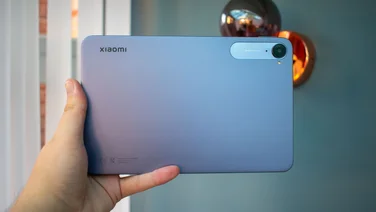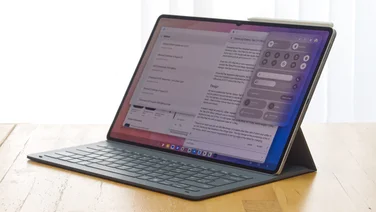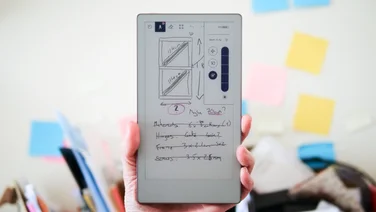To help us provide you with free impartial advice, we may earn a commission if you buy through links on our site. Learn more
- 12.9in Apple iPad Pro (2018) review: What you need to know
- 12.9in Apple iPad Pro (2018) review: Price and competition
- 12.9in Apple iPad Pro (2018) review: Design and key features
- 12.9in Apple iPad Pro review: Second generation Apple Pencil
- 12.9in Apple iPad Pro review: USB Type-C
- 12.9in Apple iPad Pro review: Performance, display and battery life
- 12.9in Apple iPad Pro review: Cameras, speakers and microphones
- 12.9in Apple iPad Pro review: Verdict


















- Incredibly fast
- USB Type-C support
- Edge-to-edge display
- Hugely expensive
- Not as flexible as a proper laptop
The 12.9in iPad Pro (2018) is at the centre of a battle at Apple HQ. Not a literal battle. I’m not talking Jony Ive in a chain mail tabard prodding a sharpened pike at Tim Cook (although that’s an image I’m going to struggle to get out of my head). No, I’m talking about the struggle over the future of mobile computing. More specifically, the battle between iPad and MacBook.
Now into its third generation, the 2018 12.9in iPad Pro is a device that’s powerful and capable enough to take on traditional portables such as the MacBook Air and 12in MacBook at their own game. It will soon be able to run full Photoshop, it’s fast enough to hold its own and is vastly competent in every conceivable area.
Yet, there are still some pretty major roadblocks to using an iPad Pro in a professional environment and, increasingly, those roadblocks feel artificially imposed. It’s as if Apple wants the iPad to become a professional tool, but can’t bring itself to unleash it fully.
READ NEXT: Microsoft Surface Pro 6 review
12.9in Apple iPad Pro (2018) review: What you need to know
I’ll get onto what those impediments are later on in this review. For now, though, let’s get the big details out of the way.
This is the latest version of Apple’s 12.9in iPad Pro. It’s the tablet Apple says it wants you to replace your laptop with. It’s best used in conjunction with the add-on keyboard and the Apple Pencil stylus, both of which are “optional” extras that have to be purchased separately.
And this model marks the biggest redesign of the iPad Pro yet. Apple has not only improved performance in 2018, as it does annually, it has also radically revamped the design. These changes include removing the Touch ID sensor (replacing it with Face ID just like on the latest iPhones), slimming the bezel down, squaring off the edges of the tablet and redesigning the keyboard case and Apple Pencil.


















12.9in Apple iPad Pro (2018) review: Price and competition
It’s also much more expensive, following the rather unfortunate trend of rising prices for pretty much all tech-related products. The basic 12.9in iPad Pro with 64GB of storage will set you back £969, the new Smart Keyboard Folio costs £199 and the second-generation Apple Pencil is £119.
Tot all of that up and you’ll be paying £1,287 for your a new 12.9in iPad Pro. Alternatively, if you want the top-spec Wi-Fi and cellular iPad Pro with 1TB of storage and all the accessories, you’ll be paying a heartstopping £2,187. Gee whizz, that’s a lot of money.
Suffice to say, this brings the 12.9in iPad Pro into direct competition with full-blown detachable 2-in-1 laptops such as the Microsoft Surface Pro 6 and the Google Pixel Slate. In fact, the new iPad Pro surpasses both rivals on price, although it comes with half the storage.
Buy the new 12.9in iPad Pro (2018) from John Lewis
|
Spec |
64GB, Apple A12X Bionic, Wi-Fi |
128GB, 8th gen Intel Core i5 |
128GB, 8th gen Intel Core i5 |
|
Tablet |
£969 |
£879 |
£969 |
|
Keyboard |
£199 |
£149 |
£189 |
|
Stylus |
£119 |
£99 |
£99 |
|
Total |
£1,287 |
£1,127 |
£1,257 |
12.9in Apple iPad Pro (2018) review: Design and key features
Apple has certainly upped its game when it comes to the design. Not only is this new iPad Pro more attractive and modern to look at, with its squared-off edges, rounded screen corners and edge-to-edge display, Apple has also made changes that improve the practicality of the design as a whole.
The keyboard case, for instance, is now a front and back folio design so, although it’s pricier than before, you get full protection for your iPad Pro out of the box. The keyboard case also now has two positions, instead of the one you got on the first iPad. One is as steep as before and one is a little more relaxed, making the iPad Pro much more comfortable to use on your lap. This arrangement still falls short of the flexibility of the infinitely adjustable kickstand on the Surface Pro 6 but, for my money, the iPad Pro feels more stable when it’s perched on your thighs.
Another obvious improvement Apple had to make over the previous iPad Pro was to the charging and storage of the Apple Pencil and it has taken inspiration from Microsoft’s Surface devices. Instead of awkwardly having to remove an eminently losable cap from the end of the Pencil and plug it into the tablet’s port to top up the battery, the new Apple Pencil attaches magnetically to the top edge and charges wirelessly. This hasn’t been implemented entirely perfectly – if you attach the pencil to the left or right of centre, it’ll stick but won’t charge – but it’s far, far more convenient.


















A hidden consequence of the new shape and design is that the three contacts that connect the tablet with the keyboard are no longer on the bottom edge but at the rear of the tablet. This means you won’t be able to save cash and use the new iPad Pro with your old Smart Keyboard. Owners of the first or second-generation iPad Pro might also be surprised to find that their old Apple Pencil won’t be compatible, either.
In short, if you bought a previous generation iPad Pro and are upgrading, you’re going to have to buy the lot all over again. That, if not entirely surprising, is still mildly disappointing especially as the two accessories cost a not-inconsequential £319 in total.
12.9in Apple iPad Pro review: Second generation Apple Pencil
Still, you at least get an upgrade if you opt to add the second-generation Apple Pencil to your basket when you pick up your shiny new iPad Pro and Smart Keyboard Folio. And, aside from wireless charging and being able to stick it to the top edge of the tablet whenever you’re not using it, it’s had a complete redesign.
It’s now shorter, flattened along one side and finished in a soft, matte coating, which to my mind makes it more comfortable to hold and use. The nib has a slightly softer feel to it, too, making it more akin to using a pen and paper than ever. Apple has also added touch sensitivity to the barrel, which allows you to perform various shortcuts with a light double tap.
By default, this double-tap gesture switches you between the current tool and the eraser, although it’s possible to customise it to a certain degree. You can toggle between the current and last-used tool, for instance, or use it display the colour palette instead.


















12.9in Apple iPad Pro review: USB Type-C
To give Apple some credit, there’s a good reason for it not being compatible with the first-generation Pencil and that’s because the iPad no longer has the Lightning port needed to charge it.
Instead, in possibly the most significant change to the iPad since the iPad first came about, its main connector is now no longer proprietary but standard-based. All hail USB Type-C.
Except that it’s not really what you’d expect from a USB Type-C connected device. On a Windows 10 or macOS laptop, a USB Type-C connection would allow you to connect all manner of devices: monitors, printers, calibrators, storage devices – you name it. Here, in a bout of typical Apple revisionism, USB Type-C is much more restrictive.
There is some good news: you can now use one charger to top up your laptop, tablet and phone. Plus, you can attach any old Type-C SD card reader and import photographs and video from your DSLR. You no longer have to splash out a small fortune on a bunch of Apple adapters and connectors, which has to be a good thing.


















What you can’t do is anything else you’d expect to be able to do with USB Type-C. Not yet, at least. Want to hook up a second monitor? That sort of works but, by default, connecting the iPad Pro to a USB Type-C monitor will only mirror the display. Until Apple adds pointing-device support to iOS, you won’t be able to do much more with it. iMovie is set to gain a second monitor preview, but you’ll never be able to do more than view content because you can’t manipulate what’s on screen without a mouse or touchpad.
Neither does the 12.9in iPad Pro’s USB Type-C port support mass storage. Not properly anyway. Want to hook up a hard disk or thumb drive and transfer files back and forth? You’re out of luck. The only external storage support comes in the form of photo import to the Camera Roll. You can’t even import photos directly to apps such as Lightroom – instead, you must import to the Camera Roll and from there to Lightroom. It’s a bit of a faff.
Even USB headphone support appears to be a little inconsistent. Although all the cheap USB Type-C headsets I connected worked well, a third-party USB Type-C to 3.5mm headphone adapter didn’t. And, yes, you will need one if you want to connect traditional wired headphones. One of the other new “features” in the iPad Pro this year is that Apple has removed the 3.5mm headphone jack. That’s just plain mean.


















12.9in Apple iPad Pro review: Performance, display and battery life
These all sound like petty complaints and, in fact, on paper most are simple to surmount – all except the multi-monitor support, of course. But when you take a look at the raw power available to the iPad owner today, it’s peculiar that Apple hasn’t made greater strides in these areas.
With the new Apple A12X Bionic chip inside, coupled with 6GB of RAM, the 12.9in iPad Pro (2018) is, quite simply, phenomenally powerful. Just take a look at the benchmark graphs below. In Geekbench and GFXBench, it’s not only faster than last year’s iPad Pro, but it’s also faster than the eighth-generation Intel Core i5-based Microsoft Surface Pro 6 we reviewed just a month ago. That’s pretty impressive stuff.


If that wasn’t impressive enough, remember that this is a tablet that can give you more than ten hours of continuous offline video playback, lasting 25% longer than the Core i5 Microsoft Surface Pro 6 in the equivalent test. It can’t quite match the 2017 iPad Pro for stamina or the Android-based Samsung Galaxy Tab S4, but more than ten hours in this test is better than most Windows laptops can manage.

Last, but by no means least, the display is excellent. Apple is still using IPS technology here and hasn’t moved to AMOLED yet for its iPads, but it’s excellent as always.
It’s super-sharp, with a resolution of 2,732 x 2,048 (for a pixel density of 264ppi), touch responsiveness is as good as it gets and image quality is utterly unimpeachable. Peak brightness reaches 629cd/m², contrast hits 1,529:1 and sRGB coverage is 90.9%. This is a wonderful display by any measure.
12.9in Apple iPad Pro review: Cameras, speakers and microphones
So far, I’ve covered the big headliners – the things that really make the difference between this year’s iPad Pro and last year’s. But there’s also a whole tranche of smaller improvements that take it to another level.
Things such as improved audio from the iPad’s redesigned quad-speaker array and better audio capture from its new five-microphone setup (the last iPad had “only” three). There’s also Smart HDR for the iPad’s 12-megapixel camera – although I still think you’re a bit mad if you use it as your main snapper – and also Gigabit-class 4G and eSIM support for the cellular version of the iPad Pro.


















12.9in Apple iPad Pro review: Verdict
Everywhere you look on the 2018 iPad Pro’s spec sheet, in fact, there’s a minor or a major upgrade, adding up to a huge step forward for the iPad Pro as a whole. It’s superfast and incredibly well made. It’s better in almost every conceivable way than the previous model and it even manages to beat Intel-based Windows 2-in-1 tablets for performance.
The problem I have with this iPad Pro is the same as it has been with previous models. Although it’s now as expensive as a fully-fledged laptop and just as quick, it just isn’t flexible enough to justify costing as much, if not more, than its Windows and macOS-powered counterparts.
There’s still no proper multi-monitor or pointing-device support. You still can’t always easily transfer files from one application to another without having to think quite hard about what you’re doing first. And, despite the introduction of USB Type-C, mass storage support remains limited.
Until Apple removes those roadblocks, the iPad Pro will remain a tool that only some people can use on a professional basis. For such a capable and downright gorgeous piece of hardware, that’s a crying shame.






